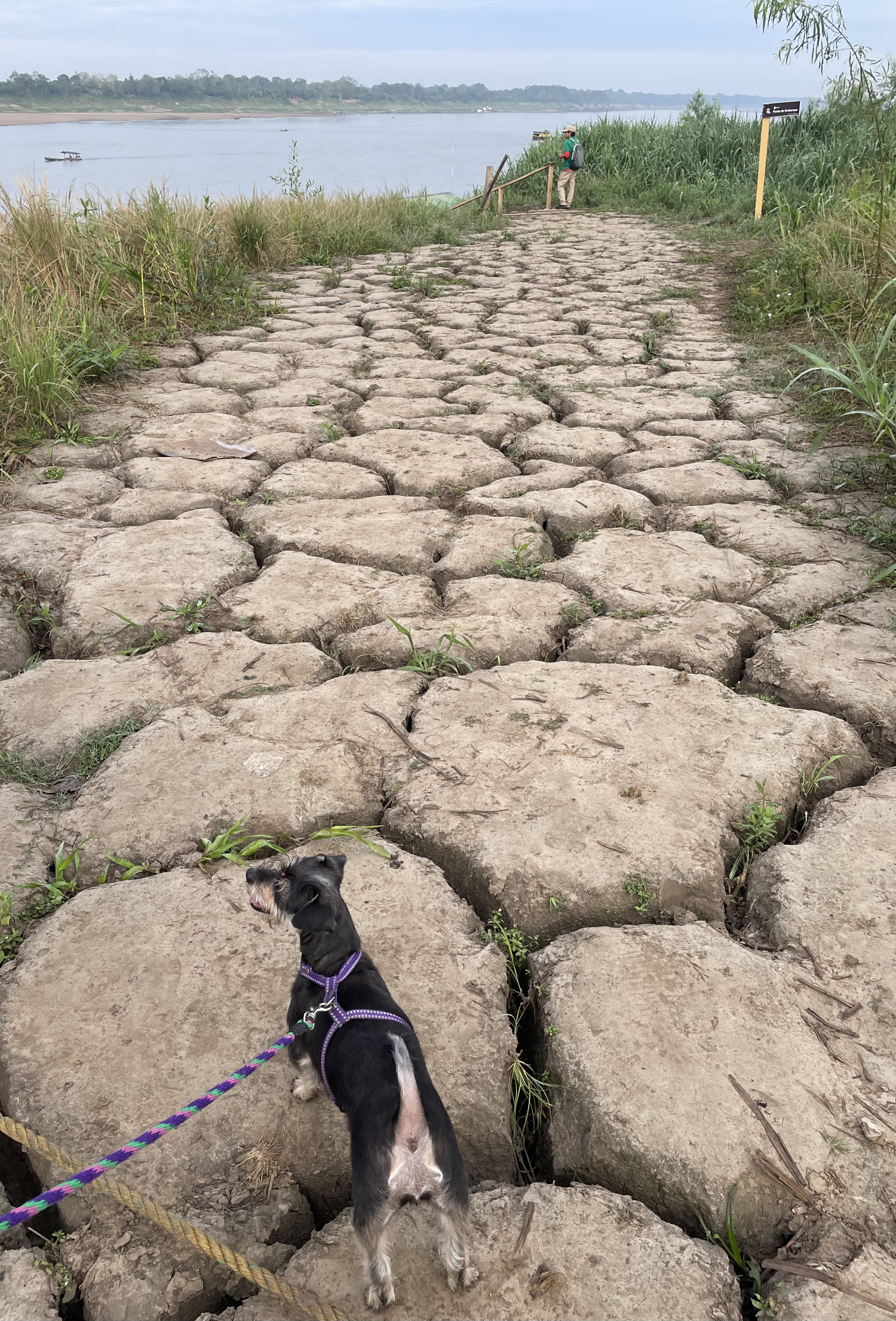30 Nov 2024 | Gabriele Herzog-Schröder
Paying a visit to the masked figures of the Tikuna/Magüta at a shallow river
At the beginning of the 19th century, the two Bavarian naturalists Johann Baptist von Spix and Karl Friedrich Philipp von Martius traveled up the Amazon on their ‘Reise in Brasilien.’ They met representatives of Indigenous societies and collected numerous items of different kinds, which, since their return to Munich, are kept in Bavaria's scientific collections. In Tabatinga, Spix witnessed a festive procession of the Tikuna and he took the masks which they used in the ceremony back to Munich. Descendants of the Tikuna, who today call themselves Magüta, still undertake such rituals and in two communities they maintain their own museums. These Indigenous museums are located in the border triangle of Brazil, Colombia, and Peru, some 60 km apart from each other, in two countries. Both are located close to the Solimões riverbanks on the upper part of the Amazon. Although internationally connected via two airports near the cities of Leticia in Colombia and Tabatinga in Brazil, this area has no road connections to other parts of the countries. Here, the river is the most important transport artery and this river, the Amazon, is currently experiencing the worst low water in history. Mask figures in the Museo Magüta in Macagua, Columbia. Photo: Gabriele Herzog-Schröder.
Mask figures in the Museo Magüta in Macagua, Columbia. Photo: Gabriele Herzog-Schröder.
My work focuses on the Amazon, a region that is of great importance for stabilizing the climate on our planet due to its enormous vegetation masses and a central goal lies in the effort to reactivate historical collections in Europe in the face of global challenges. The ethnographic assemblage that stems from the famous voyage ‘Reise in Brasilien’ is kept in the Munich Museum Fünf Kontinente. The botanical and zoological collections of Spix and Martius were essential for establishing today’s Bavarian State holdings: the Zoologische Staatssammlung and the Botanische Staatssammlung as sections of the Bavarian State Collections of Natural History (Staatliche Naturwissenschaftliche Sammlungen Bayerns, SNSB).
Curiously, these Brazilian things are now located in the same city but separated from each other, as they are stored in different institutions, and so I developed the idea of interweaving the separated parts of the collection. In an attempt to question the division of the natural science and cultural collections, I have dealt with some ethnographical objects of the voyage – namely a Tikuna mask – and with various specimens of the herbarium collection which was brought to Munich by the botanist Karl Friedrich Philipp von Martius.
To consider the knowledge and cosmovision of Indigenous representatives living today is part of the toolkit of postcolonial anthropological analysis. Thus, the opportunity to visit the Tikuna/Magüta Indigenous museums was intriguing. My field trip to view contemporary mask-figures of the Tikuna/Magüta took place in September/October 2024. The two museums are comparable in some respects – both clearly emphasize mythology and the rituals in which the masks are used – but they differ in some interesting aspects, such as the historical perspective or the agency expressed in the articulation of the exhibits. Conversations with museum representatives inspired further reflection on Indigenous perspectives on the Western construct museum as well as the attention to environmental matters. Both directors appreciated to receive the documentation of the Spix-Martius ethnographic collection, which was put together by Otto Zerries in 1982.
 Amazonia is currently experiencing an unprecedented drought. Photo: Gabriele Herzog-Schröder.
Amazonia is currently experiencing an unprecedented drought. Photo: Gabriele Herzog-Schröder.
However, the attempt to relate Indigenous understanding of their Indigenous exhibits to the historical objects in the Munich collections raises ontological queries: while their own masked figures are assigned personhood in the museums, this idea does not necessarily extend to the ancient Tikuna objects in Munich’s museum depot. For a new look at the historical collections of Spix and Martius, it is also worth retracing their route. The naturalists had traveled the upper Amazon area several decades prior to the rubber boom, which had particularly cruel effects within the territory of the Tikuna/Magüta and their Indigenous neighbours. However, already in the beginning of the 19th century, the impact of European colonialism and particularly extractivist interests were evident. In his travelogue, Spix critically pointed out the unchecked exploitation of natural resources such as turtle eggs.[1]
Traveling on a cargo ship from Tabatinga to Manaus, I had the opportunity to follow Spix's route along with reading his notes. At the same time, I could gather other passengers' perspectives on this forest region, in particular in view of the threatening situation of extreme drought. As the project progresses, it will be necessary to clarify to what extent the encounters with the Indigenous museums can support a reconsideration of the historical collections and what further relationships can be maintained with the Indigenous museums in the Amazon. The problem of drought has placed a heavy burden on both the country but also the project. Locally, it causes serious supply shortages; globally it poses a major threat to the planetary climate.
_____________
[1] Reise in Brasilien auf Befehl Sr. Majestät Maximilian Joseph I. Königs von Baiern in den Jahren 1817 bis 1820. Dritter und letzter Theil, 1831, by Johann Baptist von Spix and Carl Friedrich Philipp von Martius.

